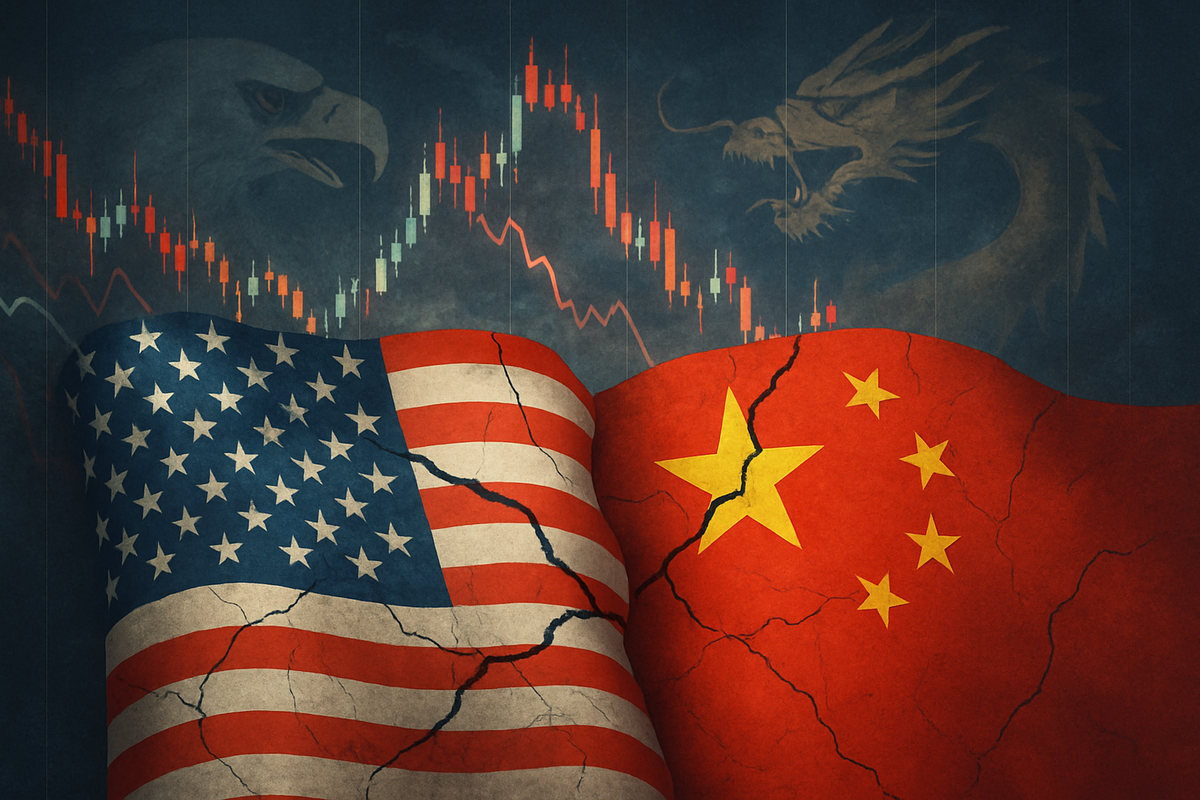
As of mid-October 2025, the long-simmering trade dispute between the United States and China has erupted into a full-blown economic confrontation, sending shockwaves across global financial markets. A rapid escalation of reciprocal tariffs, expanded export controls, and targeted sanctions from both Washington and Beijing has triggered significant stock market volatility and severely eroded investor confidence. The renewed hostilities threaten to disrupt supply chains, increase business costs, and slow international trade, pushing investors into a 'risk-off' stance amidst profound uncertainty about the future of global commerce.
Detailed Coverage of the Event
The current resurgence of trade hostilities in October 2025 is marked by a series of aggressive actions from both economic superpowers. On October 10, US President Donald Trump announced a significant threat to impose an additional 100% tariff on all Chinese imports, effective November 1, explicitly stating these would be "over and above any Tariff that they are currently paying." This declaration followed earlier US tariffs on various Chinese products, including kitchen cabinets, vanities, pharmaceuticals, and trucks, signaling a broad and intensifying economic pressure campaign. China has swiftly responded, vowing retaliation if these new tariffs are implemented, setting the stage for a tit-for-tat escalation.
Beyond tariffs, the conflict has broadened into a critical struggle over technology and essential resources. On October 9, China’s Ministry of Commerce (MOFCOM) unveiled sweeping new export restrictions on several rare earths, their production equipment, materials, and associated technologies, citing national security concerns. These controls, effective immediately for technology and by November 8 for other materials, are notably extraterritorial, impacting foreign entities whose products contain even 0.1% Chinese-origin controlled rare earth items or utilize Chinese-origin rare earth technologies. This move directly counters earlier US actions, which expanded export controls to affiliated units of restricted entities and imposed restrictions on advanced semiconductor chips, with Washington now threatening new controls on "any and all critical software" to curb China's technological ambitions.
Adding to the friction, both nations have introduced new port fees on each other’s commercial ships, effective October 14. China’s levies specifically target US-owned, operated, or built vessels, while the US fees are aimed at bolstering American shipping companies. In a further display of escalating tensions, China sanctioned five US-linked subsidiaries of South Korean shipbuilder Hanwha Ocean on October 14. This move is widely interpreted as a direct counter to US shipbuilding initiatives and underscores Beijing's increasingly assertive approach to global trade and geopolitical influence. Despite these escalations, a meeting between President Trump and Chinese President Xi Jinping is still anticipated at the Asia-Pacific Economic Cooperation (APEC) summit in South Korea at the end of October or early November, offering a glimmer of hope amidst the deepening rift.
Initial market reactions have been immediate and severe. On October 14, major US stock indices experienced sharp declines, with the Dow Jones Industrial Average dropping 504 points (1.1%), the S&P 500 falling 1.3%, and the Nasdaq Composite shedding nearly 2%. London's FTSE 100 also saw a 0.44% decline on the same day. These losses followed a brief market rally on October 13, spurred by initial, albeit fleeting, signs of easing tensions, highlighting the extreme sensitivity of markets to every shift in rhetoric. The Cboe Volatility Index (VIX), often called Wall Street’s "fear gauge," surged above 22, signaling heightened anxiety among investors. Technology and AI-focused stocks, which had previously driven market gains, led the losses, with companies like Nvidia (NASDAQ: NVDA), Tesla (NASDAQ: TSLA), and Oracle (NYSE: ORCL) experiencing notable share price drops. The mining sector also faced significant pressure, with Anglo American (LSE: AAL), Glencore (LSE: GLEN), and Rio Tinto (LSE: RIO) seeing declines due to their heavy reliance on Chinese demand for industrial metals.
Companies Navigating the Crosscurrents
The escalating trade war between the US and China is creating a stark landscape of winners and losers among public companies, forcing strategic re-evaluations and accelerating supply chain diversification. In the critical technology and semiconductor sectors, US giants heavily reliant on the Chinese market or manufacturing are facing significant headwinds. Companies like Qualcomm (NASDAQ: QCOM), Nvidia (NASDAQ: NVDA), Advanced Micro Devices (NASDAQ: AMD), Micron Technology (NASDAQ: MU), and Intel (NASDAQ: INTC) are particularly vulnerable. They face the dual threat of increased tariffs on components imported from China and restricted access to the lucrative Chinese market due to export controls on critical software and China's own rare-earth mineral restrictions. Tech behemoths with extensive Chinese manufacturing operations, such as Apple (NASDAQ: AAPL), which assembles a substantial portion of its iPhones in China, and Tesla (NASDAQ: TSLA), with its significant Chinese production presence, are grappling with rising production costs and potential impacts on sales if consumer sentiment shifts or retaliatory measures intensify.
Conversely, the rare earths sector is witnessing a strategic realignment. China's new export controls on critical rare-earth metals, vital for numerous high-tech industries including electric vehicles, have significantly bolstered non-Chinese producers. MP Materials (NYSE: MP), Critical Metals (NASDAQ: CRML), and USA Rare Earth Inc. (USAR) have seen their stock prices surge, benefiting from increased demand and investment as nations scramble to diversify their supply chains away from China's dominance. These companies are now seen as pivotal in securing vital resources and are likely to receive further government incentives and strategic investments aimed at building resilient supply chains. The global automotive industry, particularly electric vehicle manufacturers, however, face potential disruptions and increased costs due to these rare-earth restrictions.
In the broader manufacturing sector, companies with extensive international supply chains are experiencing significant disruption. US manufacturers using Chinese intermediate inputs face increased operating costs, leading to price hikes for consumer goods. Conversely, American steelmakers like Nucor (NYSE: NUE) and United States Steel Corp. (NYSE: X) have benefited from policies that cut off cheap Chinese imports, leading to a spike in domestic production and employment. The trade tensions are also accelerating a trend of 'friend-shoring,' with Chinese companies relocating parts of their production to countries like Vietnam, India, and Mexico to circumvent US tariffs, creating new opportunities for manufacturers in these alternative hubs. Companies leveraging automation, robotics, and AI are also finding new efficiencies to adapt to rising costs and supply chain shifts.
Finally, the consumer goods sector and consumers themselves are feeling the pinch. US consumers are bearing the brunt of tariffs through higher prices on a wide array of goods, from electronics to textiles, disproportionately affecting lower-income households. American retailers, including giants like Walmart (NYSE: WMT), Target (NYSE: TGT), Best Buy (NYSE: BBY), and Costco (NASDAQ: COST), as well as apparel and footwear companies like Nike (NYSE: NKE), which have long relied on Chinese manufacturing, face increased import costs. While these companies would see immediate relief should tensions ease, for now, they must navigate a landscape of elevated expenses and potentially reduced consumer spending. US agricultural exporters, such as soybean farmers, have also suffered from China's retaliatory tariffs, ceding market share to competitors in other nations.
Wider Significance and Global Implications
The renewed US-China trade tensions transcend immediate market reactions, signaling profound shifts in global economic architecture and geopolitical dynamics. This escalating rivalry is accelerating several broader industry trends, most notably the fundamental reshaping of global supply chains. Multinational corporations are increasingly adopting 'China+1' strategies, actively diversifying their manufacturing and sourcing to countries like Vietnam, India, and Mexico to mitigate over-reliance on China. While this enhances supply chain resilience, it introduces new logistical complexities and often higher costs, which are frequently passed on to consumers. The push towards 'reshoring' or 'friend-shoring' is gaining momentum, especially in high-tech and strategic sectors, though challenges like infrastructure gaps and loss of manufacturing expertise persist.
The technology sector remains at the epicenter of this economic battle, characterized by an intense race for technological leadership and a growing 'techno-nationalism.' US export controls, particularly on advanced AI chips, have led to a significant decline in American semiconductor exports to China. In response, Beijing has retaliated with bans on exports of critical high-tech materials like gallium and germanium, causing global price increases and prompting both nations to heavily invest in self-sufficiency initiatives such as the US CHIPS Act and China's 'Made in China 2025' strategy. This struggle risks creating a 'technological fracture,' where two distinct, competing ecosystems emerge, forcing companies worldwide to navigate an increasingly bifurcated technological landscape. Beyond tech, the agricultural sector, particularly US soybean farmers, continues to suffer from lost market access to China, which has shifted its purchases to South American nations, leading to price collapses and financial distress.
The ripple effects of these tensions extend globally, impacting competitors and partners alike. Southeast Asian nations, such as Vietnam, Malaysia, and Thailand, have experienced both opportunities from trade diversion and the challenge of being caught in the crossfire. They have seen increased exports to the US as companies relocate production, but also face the risk of becoming conduits for Chinese goods attempting to bypass tariffs. Europe, while potentially benefiting from redirected Chinese exports, also grapples with the uncertainties and strains on US-EU relations, sharing concerns over China's unfair trade practices. Global foreign direct investment (FDI) has also seen a 'paralysis,' with frequent policy changes and economic unpredictability hindering long-term planning.
From a regulatory and policy standpoint, the trade war has cemented tariffs and export controls as primary tools of economic statecraft. Both the US and China are expected to continue implementing stringent import restrictions, export controls, and subsidies for critical domestic industries, driving a broader trend towards economic decoupling. This strategic rivalry is transforming the global economy from an integrated system into a more fragmented, bloc-oriented structure, heavily influenced by national security concerns and the pursuit of technological supremacy. Historically, trade wars rarely yield clear winners, as evidenced by precedents like the Smoot-Hawley Tariff Act of 1930, which exacerbated the Great Depression, and the 19th-century Opium Wars. These historical lessons underscore the potential for higher consumer costs, reduced economic growth, increased market volatility, and even geopolitical instability, serving as stark warnings about the unintended and often severe consequences of protectionism.
What Comes Next: Navigating the Uncertain Path Ahead
The trajectory of US-China trade tensions remains highly unpredictable, with short-term fluctuations balanced against a long-term trend of strategic competition and economic decoupling. In the immediate future, despite recent aggressive actions, there's a delicate balance between escalating rhetoric and a potential for de-escalation. A critical deadline for a broader trade deal looms around November 10, 2025, with ongoing negotiations aiming to prevent further tariff increases. While US President Trump has, at times, adopted a more conciliatory tone, the recent imposition of reciprocal port fees and expanded rare earth export controls by China underscores the volatile nature of these interactions. A temporary tariff reduction is currently in effect, but China has made it clear that a "talks and threats" strategy from the US is unacceptable, suggesting a need for more stable engagement to truly ease tensions.
Looking further ahead, the long-term outlook points towards sustained strategic competition, particularly in critical technologies, military capabilities, and trade. Both the US and China are committed to reducing economic interdependence and striving for greater self-sufficiency. The US is pushing for reindustrialization and reshoring manufacturing, while China is actively diversifying its trade partners beyond the US, showing resilience in its exports to Europe, Southeast Asia, and Africa. This diversification strategy by China is gradually weakening the impact of US tariffs, as Beijing is no longer solely reliant on the American market. The strategic pivots for the US will likely continue to involve leveraging tariffs and export controls as key policy instruments, pressuring allies to scale back ties with China, and focusing on national security in trade. China, in turn, is expected to expand its export controls on critical minerals to strengthen its bargaining position, while also bolstering its domestic value chains and attracting foreign investment.
This environment presents both significant market challenges and emerging opportunities. Businesses will continue to grapple with increased costs, disrupted global supply chains, and heightened market volatility, particularly in currency and commodity markets. Sectors like technology (e.g., Apple, Tesla, semiconductor firms like Micron (NASDAQ: MU) and Intel (NASDAQ: INTC)), manufacturing, and agriculture (US soybean farmers) remain highly vulnerable to tariffs, export controls, and shifting demand. However, opportunities are emerging for companies that can offer stable and diversified supply chain solutions, particularly outside the US-China orbit. Western rare earth producers (e.g., Critical Metals (NASDAQ: CRML), USA Rare Earth (USAR), MP Materials (NYSE: MP)) are poised for growth as governments invest in securing vital resources. Companies that strengthen their resilience, anticipate geopolitical disruptions, and leverage spaces left vacant by competitors will be better positioned to thrive. The push for reshoring could also spur new investments in domestic manufacturing hubs in the US, creating localized opportunities.
Potential scenarios range from a temporary de-escalation, possibly an extended truce with further tariff pauses, to a persistent escalation leading to deeper economic decoupling. A temporary tactical escalation, where both sides implement aggressive policies only to revert after realizing the economic costs, is also plausible. However, the most concerning scenario involves continued escalation, with the US imposing even higher tariffs and China tightening controls on critical exports, potentially leading to substantial economic losses for both nations, including reduced GDP and job losses. While tough rhetoric might serve as a catalyst for serious negotiations, ultimately, the interplay of political rhetoric, economic pressures, and national security interests will continue to shape the unpredictable trajectory of US-China trade relations, demanding constant vigilance from investors and businesses alike.
Comprehensive Wrap-up: Navigating a Fragmented Global Economy
The ongoing US-China trade tensions, dramatically re-escalated in October 2025, represent a critical juncture in global economics, underscoring a fundamental shift from integrated globalization towards a more fragmented, security-driven world order. Key takeaways from this period of renewed hostility highlight a rapid increase in protectionist measures, including reciprocal port fees, expanded rare earth export controls by China, and threats of a 100% tariff on Chinese goods by the US. This tit-for-tat escalation, coupled with strong rhetoric, confirms that national security concerns are now central to economic policy, overshadowing purely commercial considerations and challenging decades of global interdependence.
The market assessment reveals an immediate and severe negative reaction across global financial markets. Major indices experienced sharp declines, while industrial metal miners, shipping companies, and technology firms bore the brunt of the sell-off. The Cboe Volatility Index (VIX) surged, reflecting heightened investor anxiety. While brief periods of calm may emerge from conciliatory remarks, the underlying volatility remains high. Analysts warn that a full-blown trade war, with tariffs reaching extreme levels, could effectively shut down trade in certain sectors, leading to a projected contraction in global trade for 2025. The International Monetary Fund (IMF) has cautioned that a renewed US-China trade war could significantly slow global output, even as it maintains a slightly optimistic baseline for overall global GDP growth.
The lasting impact of these tensions is the acceleration of economic decoupling and strategic rivalry. This fundamental restructuring of global trade prioritizes regional blocs and diversified sourcing, commonly termed 'reshoring' or 'friend-shoring,' as companies strive to reduce geopolitical dependencies. Manufacturing, technology, agriculture, energy, and healthcare sectors are all grappling with increased costs, disrupted supply chains, and the imperative to build domestic resilience. The trade war has already slashed bilateral trade significantly, with warnings of full economic decoupling. This structural shift demands that businesses and governments recalibrate long-term strategies, acknowledging that a return to pre-2018 trade norms is increasingly unlikely.
Moving forward, investors must brace for continued volatility and uncertainty. Key watch points include diplomatic developments and policy announcements from both the US and Chinese leadership, particularly concerning the November 1 deadline for new US tariffs and any further expansion of trade measures, such as new technology export controls or capital flow restrictions. Investors should also closely monitor supply chain resilience, focusing on companies with robust R&D and diversified production capabilities. Sector-specific performance in technology, industrial metals, agriculture, and shipping will be crucial indicators. Furthermore, the broader geopolitical landscape and its influence on economic policy, alongside movements in currency and bond markets, will provide essential insights into market sentiment. Recognizing these long-term structural shifts in global trade patterns is paramount for strategic asset allocation and navigating the complex investment landscape in the coming months and years.
This content is intended for informational purposes only and is not financial advice





